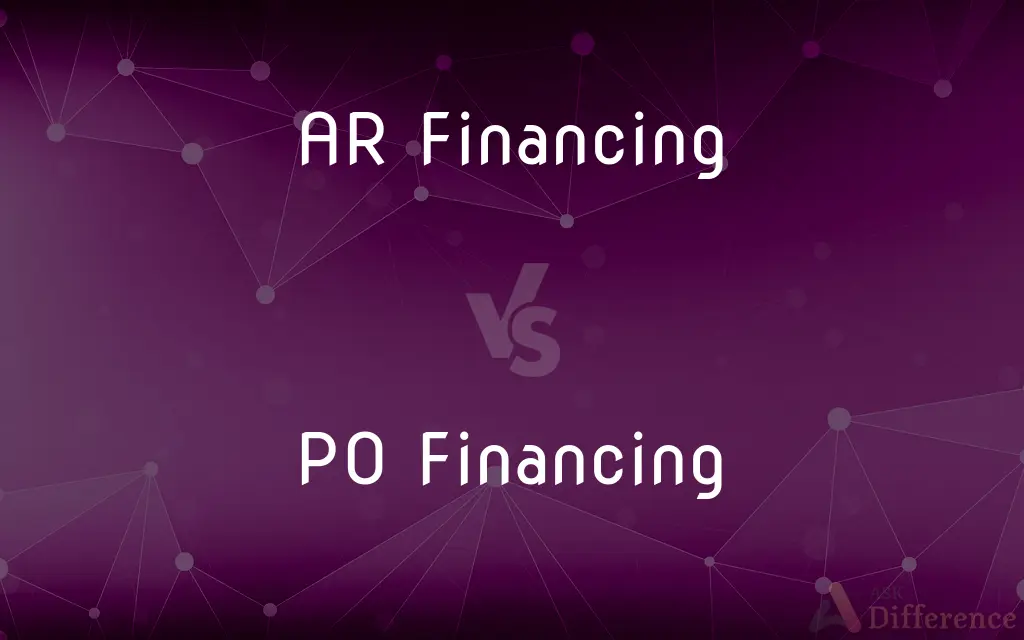AR Financing vs. PO Financing — What's the Difference?
By Maham Liaqat & Urooj Arif — Published on February 22, 2024
AR Financing involves borrowing against receivables, while PO Financing funds suppliers to fulfill customer orders, each catering to different stages of the sales cycle.

Difference Between AR Financing and PO Financing
Table of Contents
ADVERTISEMENT
Key Differences
Accounts Receivable (AR) Financing and Purchase Order (PO) Financing are two financial services used by businesses to improve cash flow and fund operations, but they operate at different points in the sales cycle. AR Financing, also known as invoice financing, allows businesses to receive immediate funds based on the value of their outstanding invoices. This method is beneficial for businesses that have completed a sale but are waiting on payment, providing them with the necessary liquidity to continue operations without waiting for payment terms to lapse.
PO Financing is used when a business has received a purchase order from a customer but lacks the funds to fulfill the order. In this scenario, a financing company pays the supplier directly to produce and deliver the goods needed, thus enabling the transaction to proceed. The business can then fulfill its customer orders without needing to tie up its capital in inventory.
AR Financing is typically a recourse for businesses that have a solid track record of sales and receivables from creditworthy customers. It's a flexible financing option that allows businesses to access a portion of the funds tied up in unpaid invoices. Conversely, PO Financing is ideal for companies that have reliable customers and confirmed orders but need financial assistance to cover the cost of goods sold (COGS) before making a profit.
The choice between AR and PO Financing depends on the business's needs and the stage of the transaction. AR Financing is more about accelerating cash flow from sales that have already been made, while PO Financing is about securing the ability to make sales by ensuring the business can afford to supply the products ordered.
Both financing options provide businesses with the means to manage their cash flow more effectively, but they come with different costs, terms, and conditions. AR Financing is generally less risky for lenders since it is backed by invoices for completed sales, potentially offering lower interest rates compared to PO Financing, which is seen as riskier due to the advance being made on the basis of future sales.
ADVERTISEMENT
Understanding the differences between these financing methods is crucial for businesses looking to optimize their cash flow and funding strategies. By choosing the appropriate option, businesses can maintain operational efficiency, fulfill customer orders, and achieve growth objectives without the constraints of cash flow gaps.
Comparison Chart
Definition
Borrowing against the value of outstanding invoices.
Funding suppliers to fulfill a customer's purchase order.
Purpose
To accelerate cash flow from sales already made.
To finance the cost of goods sold for customer orders.
Suitable For
Businesses with solid sales and waiting on payment.
Businesses with confirmed orders but lacking funds to produce.
Risk Level
Lower, backed by completed sales.
Higher, based on the potential of future sales.
Interest Rates
Generally lower due to lower risk.
Potentially higher due to higher risk.
Stage in Sales Cycle
Post-sale
Pre-sale
Repayment
Based on invoice payments from customers.
After the customer pays for the delivered order.
Ideal Users
Companies with long payment cycles.
Companies needing upfront funds to fulfill orders.
Compare with Definitions
AR Financing
Financing based on unpaid invoices.
The company used AR Financing to cover operational costs while awaiting payment.
PO Financing
Facilitates order fulfillment.
Without PO Financing, fulfilling the surge in orders would have been impossible.
AR Financing
Depends on customer creditworthiness.
Their eligibility for AR Financing improved with high-quality receivables.
PO Financing
Financing to produce goods for a confirmed order.
PO Financing enabled them to purchase the materials needed for a large order.
AR Financing
Quick access to capital.
AR Financing provided immediate funds to take advantage of a timely opportunity.
PO Financing
Based on the purchase order value.
They received PO Financing amounting to 80% of the purchase order's value.
AR Financing
Improves cash flow.
AR Financing helped bridge the cash flow gap created by net-60 payment terms.
PO Financing
Helps with growth without diluting equity.
PO Financing supported their expansion without needing to seek additional investors.
AR Financing
Tailored for completed transactions.
After delivering the project, they sought AR Financing to cover the receivables period.
PO Financing
Suited for manufacturing and distribution.
The distributor used PO Financing to pay suppliers for a pivotal contract.
Common Curiosities
What is AR Financing?
AR Financing is a financial service where businesses borrow money against the amounts due from customers, providing liquidity while awaiting payment.
What impact do these financing options have on a business's cash flow?
Both options improve cash flow by providing immediate access to funds, but they should be used judiciously to manage costs effectively.
How does PO Financing work?
PO Financing involves a financial institution paying suppliers on behalf of a buyer to manufacture and deliver goods for a customer order, allowing the business to fulfill the order without using its own capital.
Is PO Financing suitable for all businesses?
It's particularly suitable for businesses that need to fulfill large orders but lack the funds to cover the production costs upfront, such as manufacturers and wholesalers.
Who can benefit from AR Financing?
Businesses with solid sales and receivables from creditworthy customers but experiencing cash flow gaps due to delayed payments can benefit from AR Financing.
What are the risks associated with PO Financing?
The risks include dependency on the customer's ability to pay for the completed order and potential higher costs due to the financing's riskier nature.
How do businesses qualify for these financing options?
Qualification depends on the creditworthiness of the business's customers, the value of the purchase orders or invoices, and the historical performance of the business.
Can new businesses without extensive sales history use PO Financing?
New businesses can qualify for PO Financing if they have confirmed purchase orders from reputable customers, even without a long sales history, as the financing is based more on the customer's creditworthiness than the business's history.
Does using PO Financing affect a business's debt-to-equity ratio?
PO Financing is usually structured as a type of short-term debt, which can affect a business's debt-to-equity ratio, but since it's tied directly to sales, it's often seen as a self-liquidating form of financing.
Can a business use both AR and PO Financing?
Yes, a business can use both financing methods at different stages of their operations, leveraging AR Financing post-sale and PO Financing pre-sale to optimize cash flow.
What documentation is required for AR Financing?
Businesses typically need to provide financial statements, accounts receivable aging reports, and details of the invoices they wish to finance.
How quickly can a business access funds through AR Financing?
Funds from AR Financing can often be accessed within a few days of approval, making it a quick solution for cash flow needs.
What happens if the end customer doesn't pay on an order financed through PO Financing?
The business is typically responsible for repaying the financing, even if the end customer fails to pay, making it crucial to have reliable customers.
What's the difference in costs between AR and PO Financing?
AR Financing typically has lower costs due to the lower risk associated with lending against completed sales, while PO Financing may have higher costs due to the higher risk of financing pre-sale production.
Why choose AR Financing over a traditional loan?
AR Financing is often more accessible and flexible, with potentially lower interest rates for businesses with strong receivables, compared to the stricter requirements and terms of traditional loans.
Share Your Discovery

Previous Comparison
Buchner Funnel vs. Hirsch Funnel
Next Comparison
Square Meters vs. Meters SquaredAuthor Spotlight
Written by
Maham LiaqatCo-written by
Urooj ArifUrooj is a skilled content writer at Ask Difference, known for her exceptional ability to simplify complex topics into engaging and informative content. With a passion for research and a flair for clear, concise writing, she consistently delivers articles that resonate with our diverse audience.
















































